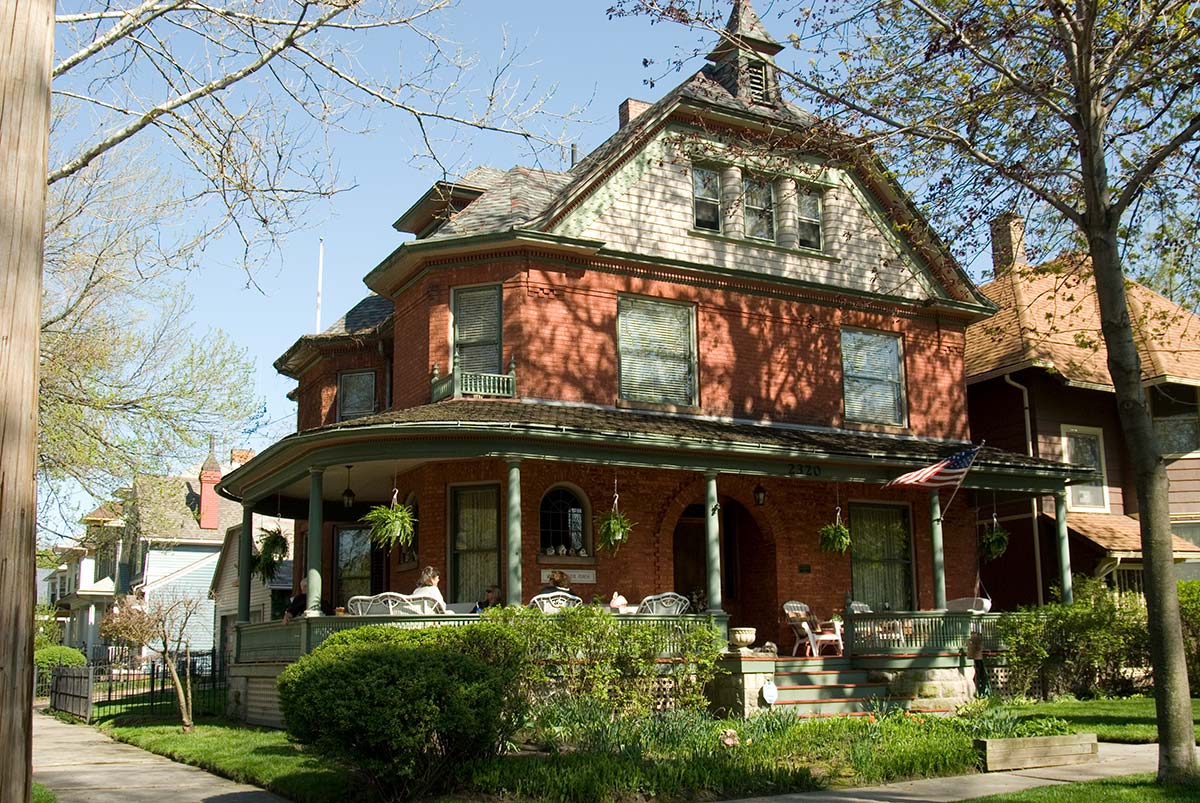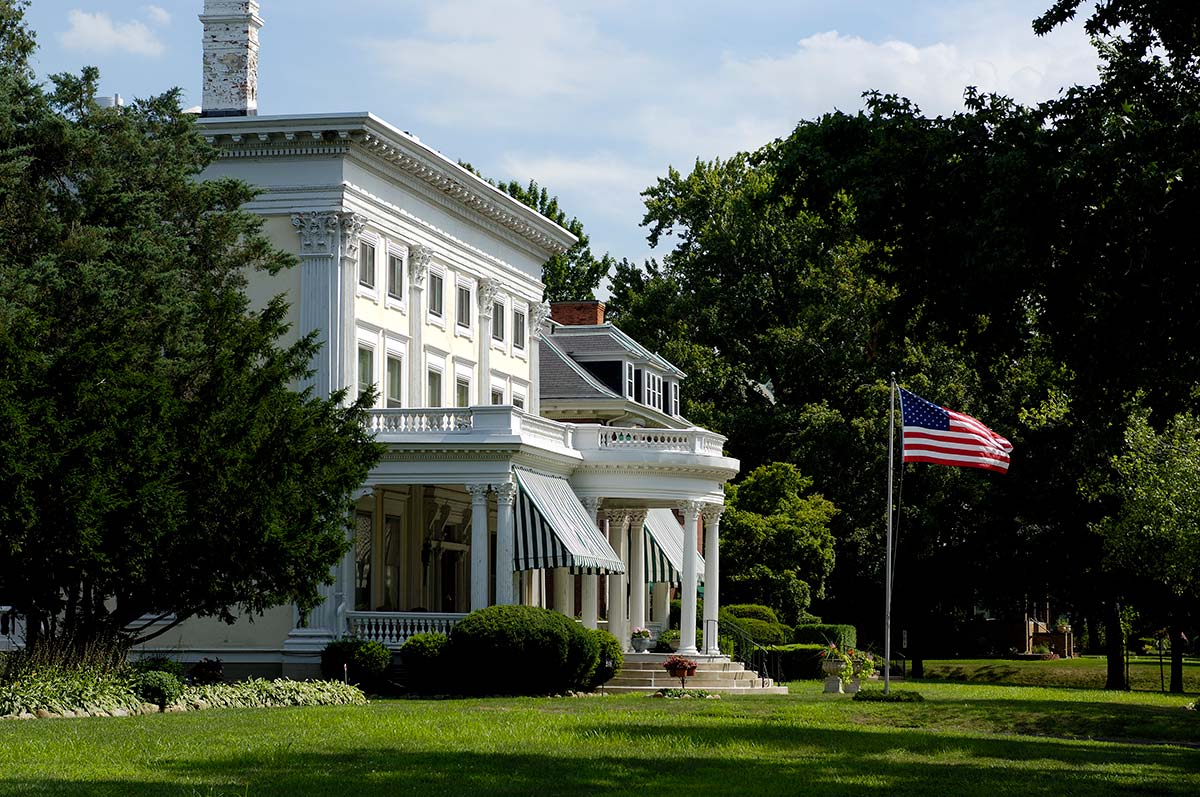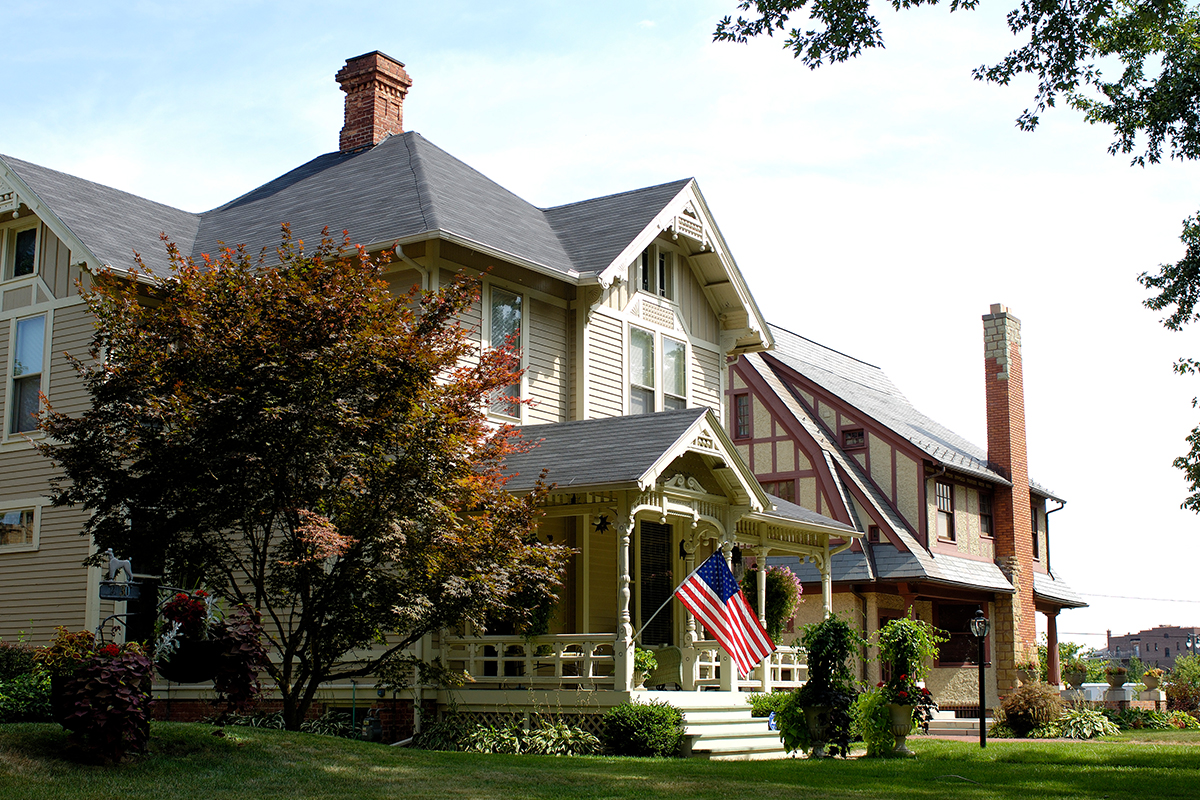Take a self-guided tour of the Historic Old West End of Toledo!
This neighborhood is one of the best kept secrets in the country with 25 city blocks making up one of the largest collections of late Victorian homes left standing in the United States. Frank Lloyd Wright studied this area in his planning of his Oak Park Project in Illinois. Pristine examples of Colonial, Georgian, Italian Renaissance, Queen Ann, Dutch Colonial, French Second Empire and Arts and Crafts homes fill these streets. We invite you to experience our rich and glorious history and architecture.
For more details, visit www.toledooldwestend.com.
Collingwood Boulevard
Rudolph Bartley House
1855 Collingwood Blvd. (1905)
This is Toledo’s only intact Chateau style structure designed after a 16th Century French Renaissance Chateau. This mansion was appropriately built with massive hand-carved sandstone and roofed with red clay tile.
Reynolds - Secor House
2035 Collingwood Blvd. (1887)
Characteristic features of this Queen Anne style house include numerous gables, multi-planed roof and wrap-around porch bee. Victorian ornamentation showcased with sunbursts, scroll tile, various window treatments and a dragon on the southern pitch of the roof. Pillars and spindles in the balustrade resemble furniture legs.
Hopkins - Berdan House
2038-40 Collingwood Blvd. (1892)
This house is one of the best examples of the shingle style in the Old West End. Although originally built as a twinplex, the exterior is asymmetric, having a northern tower with conical cap and battlement windows. Note also the gabled dormers and roof.
Edward Ford House
2205 Collingwood Blvd. (1901)
Designed by George S. Mills, this house is an original interpretation of Renaissance Revival design and decoration. The yellow brick is a striking contrast to the red terra-cotta moldings and ornaments. Bowed windows on the exterior are repeated in the unusual elliptical dining room.
John Waite House
2256 Collingwood Blvd. (1892)
The Italian Renaissance style of this house is reflected in its rectangular design with composite columns, brick walls and sandstone trim. A large selection of carved stone and zink panels is displayed above the windows on the soffit area, on the two-story bay and on the porch.
Christian Gerber House (Collingwood Arts Center)
2413 Collingwood Blvd. (1872)
Some of the most prominent Second Empire features of this house are the mansard roof with arched dormers which lie under the central tower, as well as a tower which is bracketed with large piers. The upward vertical thrust of the facade is affected by the alignment of the windows and brackets.
Gerald James “Jimmy” Hayes House
2709 Collingwood Blvd. (1926-27)
Designed by Harry Wachter, the exterior of this house is an eclectic assemblage of styles. Tudor influence is seen in the half-timbering, while the rounded arches and extensive use of patterned ceramic tiles on the front porch indicates a Spanish influence. Hayes was the reputed king-pin of Toledo gambling in the ‘20s/early ’30s.
Fred E. McCaskey House
2717 Collingwood Blvd. (1899)
The expansive full porch of this house has Doric column supports and the double central door is flanked by fluted Ionic columns. The original carriage house can be seen at the rear of the property.
Thomas Marlow House
2729 Collingwood Blvd. (1904)
This Gothic Revival style house includes wood siding, shingles and brick. The second story lancet window is flanked by bays with carved verges, dental work, large support brackets and diamond panes. Over the doorways and windows are Gothic arches with carved spandrels. The brick porch has ceramic tile inserts.
Thomas A. Devilbiss House
3015 Collingwood Blvd. (1902)
The most striking aspect of this house is the imposing front entry featuring a two story, flat roofed portico highlighted by enormous full length Corinthian fluted columns with acanthus leaf caps. Over the entrance is a large gambrel dormer which is flanked by dormers with Roman arched windows. At the corners of the house are Corinthian capped pilasters.
Parkwood Avenue
Edson Baumgardner House
2015 Parkwood Ave. (1884)
The cost of building this house in 1884 was $10,000. Historic records label this house as anywhere from Georgian Colonial Revival to Neoclassical. Features include three window dormers, window trimmed with double Ionic columns, Gothic tracery in the upper casements and dentillated dormers and cornices.
Harry Wachter House
2020 Parkwood Ave. (1910)
Formerly located at 650 Lincoln Street behind the museum, this house is an excellent example of English Cottage Craftsman style. Designed by Harry Wachter in 1910 as his own residence, this house exhibits a large central brick chimney with stone accents, deep recesses supported by Doric columns, and a steep mansard roof.
William A. Brigham House
2049 Parkwood Ave. (1887-88)
A beautiful Queen Anne style house was built for $6000. It features an octagonal tower, large attic gables, turned and carved ornamental woodwork and stained glass windows.
Frank D. Stranahan House
2104 Parkwood Ave. (1892, altered in 1918)
Originally built for $14,000, this house once had a large, full-width front porch. In 1918 this Georgian Revival house’s front porch was removed and a one story side wing enclosed for a sunroom was added.
Clarence A. Leeper / Frank L. Geddes House
2116 Parkwood Ave. (1926-27)
One of the most palatial homes in the Old West End, this house is a very ornamental
Classic Revival mansion. The colossal Corinthian pilasters and veranda with the bowed porch element reflect late Italian Renaissance architecture.
Irving B. Hiett House
2255 Parkwood Ave. (1887)
Moved from 2241 Collingwood, this house exhibits window treatments, a wraparound porch, carved panels and galleries which characterize the varied and decoratively rich Queen Anne style.
Rollin C. Inglesby House
2404 Parkwood Avenue (1910)
This distinctive and charming cottage is a treasure chest of beauty. Unlike the pure English Cottage style, the abundance of windows gives the illusion of expansive wall space which complements the Tudor styling influence. Also, note the terrace style front porch.
Charles A. Tiedke House
2460 Parkwood Avenue (1915)
The Four-Square, Arts and Crafts outside construction on this house is contrasted to its classical interior featuring brown cherry wood. Built for Charles A. Tiedtke, of the Tiedtke Department store, this house has many exposed rafter beams and contains a 2 lane bowling alley. The original carriage house can be seen at the rear of the property.
Virginia Street
George H. Nort House
630 Virginia Street (1875)
The original farmhouse on this land, as well as the first house on the Virginia St. addition, makes this home precious to the neighborhood. The most unusual feature is the vertical panel between each set of upstairs and downstairs windows.
Acklin Avenue
Aaron Chesborough House
634 Acklin Avenue (1900)
Located on one of the small side streets, the green shingles of this house are nicely contrasted by the varying shades of green in the shrubs and trees. Note especially the Queen Anne style of the front and side views and the turret.
Scottwood Avenue
Clarence Brown House
2007 Scottwood Avenue (1883/1903)
This circa 1903 Tudor style mansion was designed by Norval Bacon and built at a cost of $4,200 replacing the fire-damaged original.
Edward Drummond Libbey House (National Historic Landmark)
2008 Scottwood Avenue (1895)
This structure combines the irregularity of the Shingle style and the symmetry of the Classical. The attic gables, granite foundation, wrap-around porch and bow windows are contrasted by the Classical style used in the unpatterned upper walls and delicate 18th century details.
Herman Dick House
2040 Scottwood Avenue (1892)
This massive 9733 sq. ft. brick home was built in the Eclectic style with Dutch influence in the gables and Ionic fluted columns on the porch and second floor.
Harry T. Dunn / James Blair House
2049 Scottwood Avenue (1915)
The exterior of this house was copied from Edward Luytens’ addition Temple Dynsley in Hertfordshire, England. The overall symmetrical design and the acanthus leaf scroll, a part of the front door decoration, are common features of the Georgian Revival style.
William H. Boshart House
2055 Scottwood Avenue
This elegant stucco Arts & Crafts style house has grand proportions. Two matching gables are predominate to the exterior. The front porch is supported by large Tuscan style columns.
Julius G. Lamson House
2056 Scottwood Avenue (1905)
The classical balance and symmetry reflect this David L. Stine designed Georgian style home which is well balanced by the front porch and side porte-cochere, in addition to the third floor dormers and widow’s walk.
Arthur Sieben House
2109 Scottwood Avenue (1902)
This Queen Anne style house also has touches and details common to the French Chateau style. The turrets on the sides of the house and finials around the windows give it that element found in the chalets of France. The stone porch has scrolled wood arches and carved exterior applique.
Ann Manor Condos
2200 Scottwood Avenue (1929)
Built originally for Sam Davis as a 59 unit apartment building in the English Tudor style. Third floor units include diamond shaped leaded glass windows with cathedral ceilings. There is also an interior courtyard with a fish pond. Ann Manor was converted to condominiums in 1996.
Dean V.R. Manley House
2260 Scottwood Avenue (1897)
This Colonial Revival home has a gambrel roof and a large front porch complete with bowed front steps.
John J. Barber House
2271 Scottwood Avenue (1897)
A synthesizing of the classic and medieval idioms are highlighted in this home. Designed by Davis L. Stine, this carved woodwork design, has foliated tracery above the windows and the frieze under the eaves distinguish this Colonial Revival style home.
Moses G. Bloch House
2272 Scottwood Avenue (1909)
One is reminded of the open plains of the Midwest when viewing this house. This adaptation of Frank Lloyd Wright’s Prairie style exhibits a low pitched hip roof, wide eaves, stucco and brick walls featuring bands of casement windows.
Albert G. Wright House
2320 Scottwood Avenue (1895)
Although there are many examples of Queen Anne style, there are few built with rose brick and mortar. Of particular interest are the multi-paned hip-on gabled roof, attic dormers and a broad and circling veranda with porch bee.
Harold Arms Terrace
2367-2405 Scottwood Ave. (1907)
One of the first examples of inner city multi-family living is this cluster of row houses. The lavish historical detail shown in this building is French Renaissance style. Of particular interest are the very decorative parapet dormers and arched sandstone porch entrance.
William W. Bolles, Jr. House
2428 Scottwood Avenue (1910)
Characteristics of this Dutch Colonial Revival style house are the pavilion windows on the side, dormers with pilasters, large pilasters around the house, gambrel roof and the Dutch door.
Edward G. Shawaker House
2487 Scottwood Avenue (1905)
Where to look first truly reflects the flavor of this brick house. The roof line has an original flair and the straight linear line of the wrap-around porch is offset just enough to draw the eye to the eyebrow dormer on the third floor. Note the placement of the turret and the steeple.
Robinwood Avenue
Charles A. Russell House
2027 Robinwood Avenue (1891)
This Queen Anne style house boasts seven gables, a domed turret, ginger-bread ornamentation, tracery on the peaks and columns which resemble furniture legs.
Michael Henahan House
2052 Robinwood Avenue (1894)
Comparable to Henry Hobson Richardson’s Trinity Church in Boston, Massachusetts, the Romanesque style of this house is characterized by a straightforward treatment of stone with its effect dependent on mass and volume rather than Victorian ornateness.
Albert E. Overmyer House
2061 Robinwood Avenue (1903)
This house is a mixture of Classical Revival and Colonial Revival styles. Classic columns, pilasters, and pediments along with side porches and sun rooms are incorporated in this house.
Johanna, John & Peter Murray House
2105 Robinwood Avenue (1900)
The shingle exterior of this house, the trim and detail, the frequent use of large rounded bays and the decorative third floor dormers were English in origin. This was combined with the impressive rough-cut American fieldstone on the porch area.
John N. Willys House
2210 Robinwood Avenue (1901)
Vast proportions, medieval detail and the Tillinghast coat-of-arms with a motto carved in stone, combined with a half-timbered Tudor style, a French mansard roof and French Gothic dormers make this house one of the most pretentious of the Old West End mansions.
Frederick Paddock House
2233 Robinwood Avenue (1892)
The lavish use of sandstone, brick and cut shingles on this 9,500 square foot house is unusual. The rambling asymmetrical designs are of the Shingle style, accentuated by the prominent tower, and a generous curving veranda. Built for $30,000 for grain merchant Frederick Paddock, it became the second largest home in the Old West End.
George Storer Jr. House
2243 Robinwood Avenue (1892)
Though originally built in the late 1800s for $9000 as a Queen Anne style, this house was extensively remodeled in 1920 by prominent architect David L. Stine for George Storer Jr. and his wife Mabel. The current formal design reflects the Tudor, or more correctly, Jacobethan Revival which flourished in America in the 1920s.
Julian H. & Lillie Tyler House
2251 Robinwood Avenue (1897)
This is a reproduction of a Roxbury, Mass. house, which includes coupled columns, a second story balcony and an elliptical fan-light over the door. The widow’s walk and portico, with the free standing columns, are distinguishing Georgian Revival features.
Frank C. Hoehler House
2256 Robinwood Avenue (1920)
The well balanced symmetry of this Italian Renaissance style house is emphasized by the arched sandstone entry, flanked by pavilion windows, well spaced second story windows and a centered dormer window. The original house on this site was a Victorian style that burned in 1919.
Emerson Apartments
2308 Robinwood Avenue (1913)
Symmetry is the keynote feature of this building which contains the first residential elevator in the city. Each floor is a single flat. The Ionic pillars give an upward sweep that draws the eye to the bowhead windows in the low structured towers.
Horton Clifford Rorick House
2313 Robinwood Avenue (1899)
This house typifies a similar version of late Victorian architecture. The asymmetric placement of the second story bay window helps to emphasize the symmetry of columns on the full front porch and the three third floor dormers. The north side is set off by a beautiful stained glass window.
Edwin J. Marshall House
2347 Robinwood Avenue (1899)
Called “The Chalet” by neighbors, this house is unique in the area with its fancy brackets and eaves, numerous window panes and a lovely wrought iron fence.
Jay C. Lockwood House
2461 Robinwood Avenue (1910)
This Spanish Colonial Revival style house shares many elements of Mission Revival and Pueblo styles of the southwest. Features include smooth plaster, stucco walls and chimney finishes and a low pitched clay tile roof. The deep overhangs match those on the garage and its sideway placement on the lot sets this house apart from its late Victorian neighbors.
Fred R. Gibson House
2611 Robinwood Avenue (1910)
The Italian style of this house is most apparent on the south side which has an unusual flat tile roof, stucco extension walls and arched windows on the second floor. Gabled dormers and fan windows face the front and side. French doors lead to a large veranda. Basket arches surround the front windows and door.
Glenwood Avenue
Thomas Van Stone House
2103 Glenwood Avenue (1892)
This Colonial Revival house has matching 2nd story front bay windows and unique multi-columned front porch with a rounded end. Large double cornice brackets add interest to the double bay wall on the north side of the house.
Jacob J. Freeman House
2274 Glenwood Avenue (1896)
A mix of irregular Queen Anne and symmetrical Colonial Revival makes this house unique. Three dormer roofs resemble witches’ hats and a large turret in front has shingles and clapboard siding.
John Winfield House
2351 Glenwood Avenue (1907)
This Arts & Crafts Four Square was built of New York yellow brick which gets its distinctive color from a high iron content. The handsome exterior is accented with sandstone trim. Square brick pillars with sandstone coping support the porch roof.
J. Heywood House
2528 Glenwood Avenue (1915)
This 3-story, 12-room Georgian Revival was designed by Bernard Becker. Gray stucco walls are complimented by red shutters, more than 100 French-hung windows, and the massive cypress pillars of the main portico. A beautiful carriage house with chauffeur’s apartment compliments the property.
Charles H. Whitaker House
2546 Glenwood Avenue (1915)
This Shingle style with Georgian influence was designed by Landgon and Hohly. The beautiful front entrance has built-in benches and a large Dutch door. Situated on a large lot surrounded by century old trees is typical of many Old West End properties.
Allan H. Emerson House
2561 Glenwood Avenue (1912)
The exterior of this house is Arts & Crafts with a blended influence of English Country style. The barrel tile roof and stucco walls along with a unique attached drive-thru garage in the back help to make this house unusual.


